Expert Guide to Fixing Clogged Drain Pipes Quickly
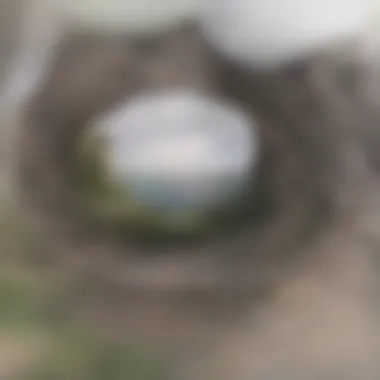
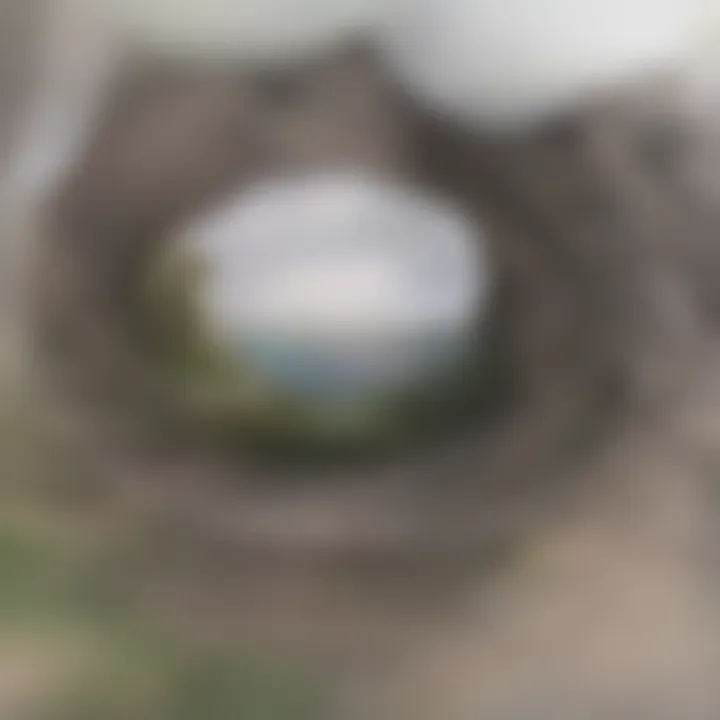
Intro
Clogged drain pipes present a common yet significant nuisance in residential settings. They affect daily activities and can lead to more severe plumbing issues if not addressed promptly. This guide aims to provide you with a nuanced understanding of how to effectively diagnose and resolve clogging issues. By exploring various techniques, tools, and preventive measures, you will be equipped to handle this problem either through DIY methods or by engaging professional help when necessary.
The following sections will detail the common causes of clogs, the appropriate tools required, and systematic steps that can be taken to rectify these issues. Additionally, we will touch on how to prevent future clogs, making this guide a comprehensive resource for homeowners and DIY enthusiasts.
Identifying Clogged Drain Pipes
Understanding the nature of a clog is the first step in remedying the situation. Clogs may manifest in several forms, such as slow drainage, unusual gurgling sounds, or even unpleasant odors. It's imperative to recognize these signs early, as they can indicate varying severity levels of blockage.
- Slow Drainage: The most common sign of a clog is slow-draining water. If you notice your sink or tub draining slowly, it might indicate debris accumulation in the pipes.
- Gurgling Sounds: When water struggles to pass through the pipes, it can create a gurgling noise. This is often a cue that there is a partial blockage.
- Foul Odors: Unpleasant smells emanating from your drains indicate stagnant water trapped due to clogs.
Common Causes of Clogs
Several factors can contribute to the formation of clogs. Identifying these can help in the prevention and resolution of draining issues:
- Hair and Soap Residue: Bathrooms are particularly prone to clogs due to hair and soap scum buildup.
- Grease Accumulation: Kitchens frequently experience blockages from grease and food particles sticking to pipe walls.
- Foreign Objects: Items accidentally dropped down the drain, such as toys or sanitary products, can lead to abrupt clogs.
Tools for Fixing Clogs
Having the right tools at hand can facilitate the unclogging process. Here are some essential tools you might need:
- Plunger: A plunger can create a vacuum effect, potentially dislodging the clog.
- Snake: A plumbing snake helps reach deeper into pipes to break apart or pull out clogs.
- Chemical Cleaners: These should be used sparingly, as frequent use can damage pipes. Always follow label instructions carefully.
Methods to Fix Clogged Drains
Resolving drain clogs often requires a combination of approaches. Here’s a step-by-step method to tackle minor clogs:
- Use a Plunger: Begin with a standard plunger. Make sure to cover overflow holes and create effective suction to dislodge the clog.
- Try a Snake: If plunging fails, insert a plumbing snake into the drain. Twist and push until you feel resistance.
- Employ Chemical Cleaners: Only if necessary, consider chemical cleaners. Make sure to follow safety guidelines when using these products.
- Remove Stopper and Clean: Remove the drain stopper and clean it as debris often collects here, contributing to clogs.
It is essential to carry out regular maintenance checks to prevent recurring clogs in drain pipes.
Preventive Measures
Taking preventive steps can significantly reduce the chances of clogs in your drain pipes:
- Regularly clean drain covers and stoppers to remove hair and debris.
- Dispose of grease and food leftovers properly, avoiding disposal down the sink.
- Conduct periodic inspections of drainage systems to catch potential issues early.
Finale
In summary, clogged drain pipes are a manageable problem when approached with the right strategies and tools. From identifying signs of a clog to employing DIY methods or seeking professional help, there are numerous ways to mitigate these issues. Regular maintenance not only addresses current problems but also aids in preventing future ones, ensuring a smooth drainage system in your home.
Preface to Clogged Drain Pipes
Clogged drain pipes represent a significant issue that many homeowners encounter at some point. Drains are essential components of any plumbing system, facilitating the disposal of waste water from sinks, tubs, and toilets. When these systems become blocked, the consequences can lead to inconvenience and even serious damage.
Understanding why drains become clogged is crucial. It allows individuals to characterize symptoms early and take action before complications arise. Being informed about proper maintenance methods can prevent future issues and protect the investment in one’s home.
There are several common causes of clogs, which include accumulation of debris, buildup from fat, oil, and grease, intrusion from tree roots, and the presence of foreign objects. By recognizing these factors, it is easier to develop a comprehensive plan for dealing with clogs when they happen.
Homeowners should also be aware that attempting to fix clogs can sometimes exacerbate the problem. Thus, knowing when to seek professional help is an important consideration. A clog that seems minor may be symptomatic of larger underlying issues, potentially leading to costly repairs.
In this article, we will examine not only the causes of drain clogs but also the signs to look for and the DIY techniques available for clearing these blockages effectively. This information will especially benefit those who wish to maintain their drainage systems proactively. Taking preventive action can save both time and money.
"Regular maintenance is a proactive measure that saves homeowners from future plumbing disasters."
Furthermore, this content addresses essential tools and supplies necessary for drain maintenance, ensuring that readers are well-equipped to handle common plumbing problems. With an understanding of these factors, the importance of clearing out clogged drain pipes becomes apparent, offering peace of mind and the comfort of a smoothly functioning plumbing system.
Understanding Drainage Systems
Understanding the drainage system is crucial for homeowners and property enthusiasts. A well-functioning drainage system prevents water from stagnating, which is vital for maintaining the structural integrity of a property. Knowing how these systems work helps in diagnosing issues, such as clogged drain pipes. Familiarity with drainage systems also aids in appreciating why clogs happen and how to effectively address them.
Components of Drainage Systems
A typical drainage system comprises several components that work together to facilitate the seamless flow of water. These include:
- Pipes: The core part of any drainage system, pipes can vary in size and material. Common materials are PVC, cast iron, and clay.
- Traps: These devices prevent sewer gases from entering your home. They also trap debris and clogs.
- Cleanouts: Cleanouts are access points that allow for inspections and maintenance of pipes.
- Sewers: Sewers are the main conduits that carry wastewater away from homes.
- Drains: These are smaller pipes that collect water from sinks, tubs, and other fixtures.
Understanding these components is essential for anyone dealing with drainage issues.
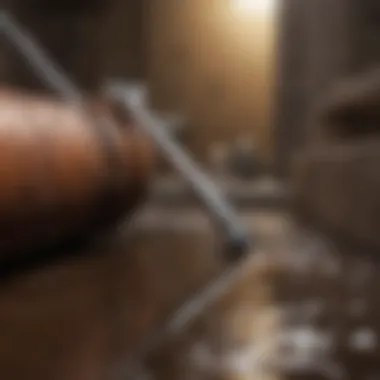
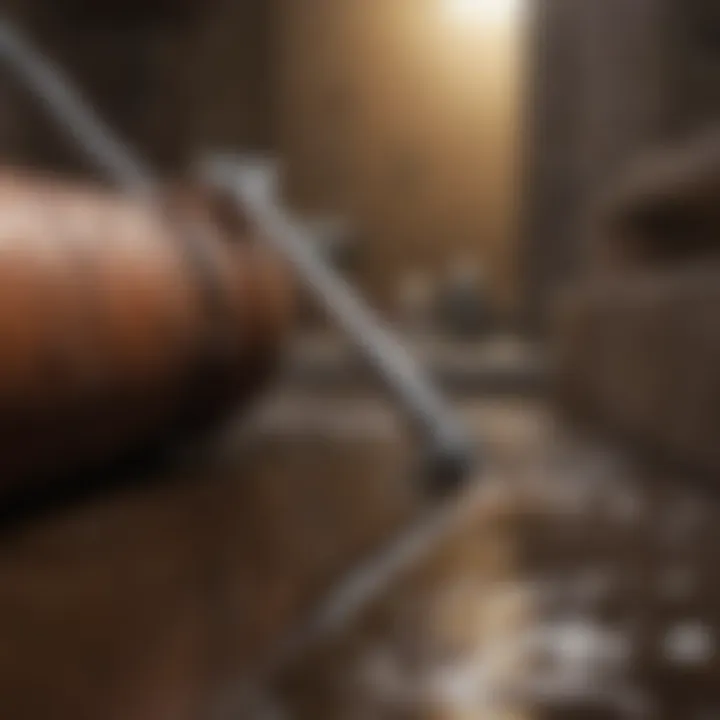
How Water Flows through a Drain Pipe
Water flow in a drain pipe is influenced by gravity and pressure differential. When you open a tap, water flows due to the pressure difference between the main supply and the atmospheric pressure. This flow starts through the drain’s vertical pipes and moves through horizontal sections until it reaches the sewer.
The angle and diameter of pipes significantly affect flow speed. Typically, pipes are sloped downward to efficiently guide wastewater away from the home. If there is a blockage, the flow gets disrupted, leading to slow drainage or complete stops.
Understanding this flow is essential for diagnosing a clog. Knowing how water moves helps identify where the clog might be and what measures to take to resolve it.
"The pathway of water through drainage systems is not only functional, but it is also essential in preventing extensive damage to homes that can arise from clogs."
In sum, being aware of the drainage system’s components and how water flows through them lays a solid foundation for tackling clogged drains effectively.
Common Causes of Clogged Drains
Understanding the common causes of clogged drains is crucial for effective maintenance and repair. This section identifies specific issues that can lead to blockages and outlines their implications. Being aware of these causes can help homeowners and DIY enthusiasts take preventive measures, saving time and money associated with extensive plumbing repairs. Clogs can lead to more significant problems, such as water damage or plumbing system failure, if left unaddressed.
Accumulation of Debris
Debris accumulation is one of the most frequent contributors to clogged drains. Over time, materials such as hair, soap residue, food particles, and dirt collect in pipes. This buildup can significantly restrict water flow. People often underestimate how much debris can accumulate. Regular maintenance and cleaning can be effective in resolving this issue. Using a drain cover can help catch larger debris before it enters the pipe.
Here are several steps for prevention:
- Install drain screens to trap hair and larger particles.
- Clean hair from bathroom sinks and shower drains regularly.
- Dispose of food waste in compost rather than in the sink.
Fat, Oil, and Grease Build-Up
The buildup of fat, oil, and grease in kitchen pipes is another common cause of clogs. These substances often solidify as they cool, sticking to the pipe walls. Over time, this can create a layer of buildup that restricts the flow of water and other materials.
To manage these issues, it is advisable to:
- Avoid pouring fat and oil down the drain.
- Use absorbent materials, like paper towels, for wiping greasy dishes.
- Clean drains with boiling water periodically to keep pipes clear.
Prevention tips:
- Use a container to collect and dispose of cooking grease.
- Flush the drain with hot water after washing greasy dishes.
Tree Roots Intrusion
Tree roots can pose significant challenges to drainage systems. The roots naturally seek moisture, which can lead them to infiltrate underground pipes. This intrusion can block water flow entirely, leading to severe drainage issues.
If you suspect tree roots are invading your pipes, consider these methods:
- Monitor your yard for signs of root growth near drainage systems.
- Use root-inhibiting products that can mitigate growth near pipes.
Regular inspection of your plumbing and surrounding vegetation can help identify potential problems early.
Foreign Objects in Pipes
Foreign objects such as toys, sanitary products, and other debris can also cause drain clogs. These items may enter the plumbing system accidentally, resulting in immediate blockages. This type of clog can often require professional removal if the object is lodged deep within the pipes.
To avoid foreign object clogs, homeowners should:
- Educate family members about proper disposal habits.
- Keep sinks and toilets clean of items that do not belong there.
"Preventive action is the best method to avoid clogs caused by foreign objects."
In summary, understanding these common causes can empower individuals to maintain their plumbing systems effectively. By addressing issues proactively, one can minimize the risks of clogged drains, ensuring a smoother flow and less invasive plumbing interventions.
Identifying Symptoms of Clogged Drains
Recognizing the symptoms of clogged drains is crucial for timely intervention and effective solutions. A clear understanding of these signs not only aids in preventing extensive damage to your plumbing system but also saves you from additional repair costs. Timely identification allows you to implement preventive measures and adopt effective maintenance practices before a minor inconvenience escalates into a significant issue.
Slow Draining Sinks and Tubs
One of the most common indicators of a clogged drain is slow draining sinks and tubs. If water takes significantly longer to drain than usual, it is often a signal that something is obstructing the flow. This can happen when debris accumulates in the pipes or when foreign objects obstruct the drainage path.
Observation of slow drainage in bathrooms or kitchens can lead you to not only identify the problem promptly but also to pinpoint if the issue is localized or part of a larger blockage in the plumbing system. Early action can often avert a major fiasco.
Unpleasant Odors
Another clear symptom of a clogged drain is the presence of unpleasant odors. An accumulation of organic matter, such as food particles or hair, often decomposes and generates foul smells. If you start noticing odors emanating from your sink or tub, it may indicate that waste is stuck somewhere within the pipes.


These odors can not only be bothersome but also signal potential health hazards due to bacterial growth. Addressing these smells quickly can maintain both hygiene and comfort within your home.
Gurgling Noises in Plumbing
Finally, gurgling noises in your plumbing system are a distinct sign of a potential clog. When air attempts to escape through a restricted passage, it creates unusual sounds. This noise can occur in various plumbing fixtures, including sinks, toilets, or bathtubs.
Ignoring these sounds may lead to worsened blockage, resulting in water backflow or even complete obstruction. Paying attention to gurgling noises gives homeowners insight into the state of their plumbing.
Being proactive in identifying symptoms of clogged drains is key to effective maintenance and can save you from serious plumbing issues later on.
DIY Methods for Clearing Clogs
DIY methods are vital in addressing clogged drain pipes. Homeowners often prefer these techniques because they can save money and time. Knowing how to handle minor plumbing issues can prevent the need for costly professional services. Moreover, these methods can be executed with readily available household items or basic tools, making them accessible for most individuals.
While DIY methods can resolve simple clogs effectively, it is important to understand their limitations. Not all clogs can be handled with these approaches, especially if there are significant blockages or damage within the pipes. Hence, knowing when to switch from a DIY approach to seeking professional help is crucial.
Using a Plunger
A plunger is a common tool often used to tackle clogs in sinks, tubs, and toilets. Using a plunger requires a few simple steps:
- Select the Right Plunger: Ensure you have a cup plunger for sinks and a flange plunger for toilets.
- Prepare the Area: Clear away any items that may obstruct your work.
- Create a Seal: Place the plunger over the drain and push down slowly to create a tight seal.
- Pump Effectively: Vigorously push and pull the plunger, maintaining the seal, for about 15 seconds.
- Check the Drain: Remove the plunger and see if the water drains properly.
This method is straightforward, often effective for minor clogs, and requires no chemical agents.
Applying Baking Soda and Vinegar
Baking soda and vinegar serve as a natural and effective combo for cleaning drains. The process is simple:
- Measure Ingredients: Pour half a cup of baking soda directly into the clogged drain.
- Add Vinegar: Follow with half a cup of vinegar. Expect bubbling as a reaction occurs.
- Cover the Drain: Use a drain cover or cloth to keep the reaction contained.
- Wait: Allow the mixture to sit for 30 minutes.
- Flush with Hot Water: After waiting, flush the drain with hot water to clear any remaining debris.
This method works well for organic material buildup, leaving your drains fresh without using harsh chemicals.
Utilizing a Drain Snake
A drain snake is a tool specifically designed to reach deep clogs. Here’s how to use it:
- Insert the Snake: Feed the snake into the clogged drain slowly until you feel resistance.
- Crank the Handle: Turn the handle clockwise to break up the clog.
- Pull Back and Repeat: Gently pull back the snake and remove any caught debris. Repeat as necessary until the drain is clear.
- Flush the Drain: After clearing, use hot water to ensure everything is gone.
This method is particularly useful for hair and other debris, especially in shower drains.
Hot Water Flush
A hot water flush is one of the simplest methods for clearing clogs. Here’s how:
- Boil Water: Start by boiling a kettle or pot of water.
- Carefully Pour: Once boiled, slowly pour the hot water down the clogged drain.
- Repeat if Needed: If the clog persists, repeat the process a few times.
This technique is effective for grease and other easily dissolvable materials.
These DIY methods can be highly effective for simple clogged drains but recognize when to call a professional plumber if issues do not resolve or worsen.
When to Seek Professional Help
In addressing clogged drain pipes, knowing when to tap into professional expertise is critical. While many drainage issues can be resolved with DIY approaches, there are specific instances where hiring a professional is not just advisable, but necessary. Relying on skilled plumbers ensures that the problem is efficiently diagnosed and thoroughly resolved.
Persistent Drain Issues
If clogs become a recurring problem, this signals potential underlying issues. Homeowners might find themselves unclogging their sinks or toilets repeatedly. Such persistence suggests that there may be a deeper complication that needs addressing. For example, a consistent blockage could indicate issues like tree roots infiltrating pipes or significant build-up of sediment. One might spend time and money on temporary fixes without solving the root cause. This is where a professional's experience becomes invaluable.
- Expertise: Professionals have the training to accurately diagnose problems that might not be evident.
- Tools: Proper equipment for deep cleaning or inspections can make a significant difference. Tools like high-pressure water jetters or sewer cameras help to identify hidden trouble spots.
Hiring a professional ensures the job is done right and reduces the risk of aggravation.
Multiple Drains Affecting at Once
Experiencing multiple clogged drains simultaneously can be alarming and indicative of a more extensive issue. When drains throughout a home are affected, the problem is often centralized deeper in the plumbing system.
In such cases, it is unwise to dismiss symptoms.
- Shared Drainage: Many drains connect to a shared line. An obstruction in this shared line can lead to multiple drains backing up at once.
- Bigger Problems: It might suggest a serious blockage that a homeowner cannot handle alone. Only a professional can ascertain the exact nature of such a blockage and implement the correct solutions.
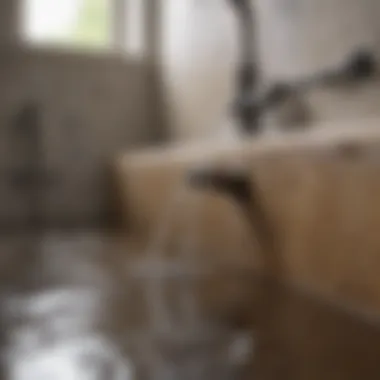

Ignoring these symptoms could lead to more damaging leaks or plumbing failures down the line. Consulting a professional can help avoid costly repairs.
Signs of Pipe Damage
Signs of damage in the drainage system can often go unnoticed until they become severe. Homeowners should be vigilant about observations that may suggest broader issues.
Some warning signs include:
- Water stains on walls or ceilings.
- Dips in the yard that might indicate leaking pipes.
- Unusual noises like banging or gurgling when a toilet is flushed or a sink is used.
- Shifts in water levels in toilets or tanks.
If any of these signs manifest, it is wise to consult a plumbing professional immediately. Inspecting and repairing pipe damage promptly helps prevent further complications, including flooding or structural damage within the property. The risk of DIY attempts in this sensitive area is high and can lead to less satisfying results.
Seeking professional help at the first sign of trouble can save homeowners significant time and expense in the long run.
Tools and Supplies for Drain Maintenance
Effective maintenance of drain pipes requires appropriate tools and supplies. Having the right items on hand not only simplifies the process of fixing clogs but also helps prevent future issues. This section will cover both basic tools and the necessary supplies for maintaining drain pipes. Proper attention to these elements plays an essential role in safeguarding your plumbing system.
Basic Tools Needed
When dealing with clogged drains, certain tools prove to be indispensable. Here are some basic tools that every homeowner should consider:
- Plunger: A standard household plunger is essential for creating suction to dislodge clogs in sinks and toilets. Its simple design allows for efficient use in various scenarios.
- Drain Snake: Also known as a plumber's auger, this tool helps reach deeper into pipes to remove stubborn clogs that other methods cannot. It is especially useful when dealing with hair, grease, or debris that are far down the drain.
- Bucket: Always keep a bucket nearby to collect any debris or water that might spill during the unclogging process. This keeps the area clean and avoids additional mess.
- Gloves: Protect your hands with durable gloves. Handling clogged material can be unpleasant and unhygienic, making gloves a necessary safety tool.
- Flashlight: A reliable flashlight is important to inspect dark areas inside cupboards or under sinks. It helps in identifying problems without straining your eyes.
Having these tools at your disposal enhances your ability to manage drainage issues promptly and effectively. Failure to prepare can complicate what might otherwise be straightforward tasks.
Chemical Drain Cleaners: Pros and Cons
Chemical drain cleaners are popular for unclogging pipes. They are easy to use, but their application comes with advantages and drawbacks.
Pros:
- Quick and Convenient: Chemical cleaners often work rapidly to dissolve minor clogs, providing immediate relief to a drainage problem.
- Ease of Use: Most products can simply be poured down the drain and left to act. Many require no special skills, making them accessible for most homeowners.
- Variety of Formulations: There are numerous types of chemical drain cleaners available, catering to various needs, whether for kitchens, toilets, or bathroom sinks.
"While these cleaners can provide quick solutions, their safety and environmental impact should not be overlooked."
Cons:
- Potential Damage: Frequent use of harsh chemicals can corrode pipes over time, particularly if they are older or made from certain materials. Long-term reliance on drain cleaners may worsen problems.
- Environmental Concerns: Many chemical cleaners contain materials that can be harmful to the environment. Disposal of these chemicals may pose additional issues.
- Limited Effectiveness: Chemical solutions may not work on every type of clog, especially if there is a significant blockage that requires mechanical removal.
Preventative Measures to Avoid Clogs
Preventative measures to avoid clogs are crucial when it comes to maintaining a functional drainage system. Regular attention can save homeowners from costly repairs and significant inconvenience. Ensuring that drain pipes remain clear is advantageous not only for immediate comfort but also for long-term property value. By proactively addressing potential issues, homeowners can extend the lifespan of their plumbing systems.
Regular Cleaning Practices
One of the most effective preventative measures is establishing a routine for cleaning drains. This helps to minimize the buildup of debris in the pipes. Homeowners can use a variety of methods:
- Boiling water: Flushing drains with hot water weekly helps dissolve grease and soap residues.
- Baking soda and vinegar: A natural solution for cleaning, this combination promotes the breakdown of blockages while also neutralizing odors.
- Cleaning traps: Regularly checking and cleaning sink traps can prevent collects from reaching deeper into the plumbing.
Incorporating these practices into a regular cleaning schedule is simple and does not require significant investment. A thorough cleaning can also act as a diagnostic measure, revealing potential problems early on.
Proper Disposal of Waste
How waste is disposed of can heavily influence the health of drain systems. Adhering to proper disposal guidelines is essential in preventing clogs.
- Food scraps: Avoid putting large amounts of food down the disposal or sink; this includes fibrous vegetables, coffee grounds, and starchy foods.
- Fats, oils, and grease: These substances can solidify in pipes, leading to severe blockages. Properly disposing of these in the trash can reduce clogging risks.
- Personal hygiene products: Items like flushable wipes, sanitary items, and cotton swabs should never be flushed.
By educating everyone in the home about proper disposal methods, you can significantly reduce the risk of clogs.
"Prevention is always easier than fixing a problem after it has occurred. Regular maintenance is key for any drainage system."
When individuals adopt these preventative measures, the overall effectiveness of the home’s drainage system improves, preventing emergency issues and promoting a smooth flow of water.
Closure
In the realm of home maintenance, the significance of understanding clogged drain pipes cannot be overstated. Clogs can lead to minor inconveniences or escalate into severe plumbing issues, causing extensive damage and costly repairs. It is essential for every homeowner and DIY enthusiast to recognize the potential causes of clogs, as well as the effective methods to resolve them.
Addressing clogged drains not only enhances your plumbing system's efficiency but also promotes a healthier living environment. Neglecting these issues can lead to unpleasant odors, water damage, and even health hazards from standing water. Simply put, being proactive about drain maintenance is a wise investment in your property’s value.
Moreover, understanding when to seek professional help is crucial. DIY methods may resolve minor clogs, but persistent issues or multiple affected drains should prompt consultation with a qualified plumber. Knowing the distinction can save you from unnecessary frustration and ensure a long-term solution to your drainage problems.
"An ounce of prevention is worth a pound of cure."
This saying rings true in drain care. By adopting regular cleaning practices and correct disposal of waste, homeowners can considerably reduce the chances of clogs. This includes knowing what items should never enter a drain and the benefits of routine maintenance check-ups.
Ultimately, the aim of this article is to equip readers with the knowledge to tackle clogged drains effectively while highlighting the importance of prevention and professional assistance. By merging practical methods with thorough understanding, individuals can maintain their drainage systems, resulting in a more functional home.
Emphasizing these elements ensures a seamless plumbing experience, ultimately benefiting your home as well as your peace of mind.















